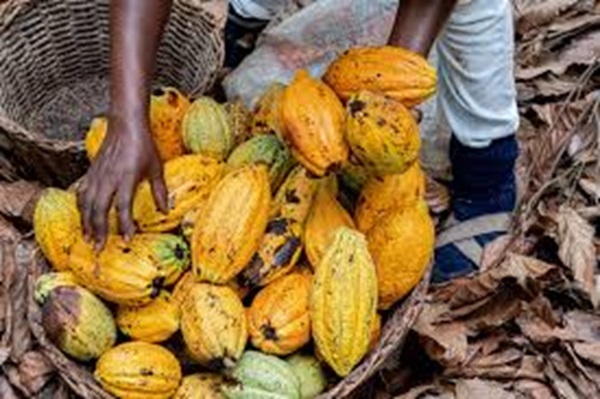Ghana is fast losing out on the export of its dominant foreign exchange earner, cocoa.
For instance, the export value of cocoa products in the first quarter (Q1) of this year, witnessed a significant decrease to US$592.2 million representing a whopping decline of 32.8% compared to the same period in 2023.
It also indicates a US$233.6 million loss in export revenue compared to the average for the past three years.
The figure is also relative to the average of US$825.8 million for the first quarters of the last year years (2021, 2022 and 2023).
The worrying development is in spite of the fact that exports of cocoa products usually peak in the first quarter of the year.
Exports of cocoa are dominated by beans. On average beans which accounted for 56.2% of cocoa exports in 2021, decreased to 51.4% in 2022, and declined further to 46.5% in 2023.
The decline is driven by a collapse in exports of cocoa beans in Q3 of the past two years. In 2021, exports of cocoa beans didn’t fall below US$225 million in a single quarter, but in 2022 and 2023 they reached lows of US$44.7 million and US$13.5 million, respectively.
According to the Q1 2024 newsletter trade report authored by the Ghana Statistical Service, the focus was on cocoa exports because of the current cocoa swollen shoot virus disease (CSSVD) with figures presented in United States (US) Dollars because cocoa is usually traded in the American greeback.
Meanwhile, analysts have also pointed to the devastating impact of illegal mining, galamsey, which is claiming large tracks of land used for the cultivation of the country’s lead export earner, cocoa.
They warned that, the results signals the need for the government to stop paying lip service to the fight against galamsey and take immediate action to reverse the trend which has the potential to sink the fragile economy further through reduction in export revenue which is badly needed to stabilize the cedi and boost international currency reserves.
Trade surplus
Meanwhile, in Q1 2024, the total trade value stood at GHC107.6 billion, comprising GHC59.5 billion in exports and GHC48.1 billion in imports.
Moreover, data from Q1 2024 shows that Asia has superseded Europe as Ghana’s leading trading partner for both exports and imports.
The report said relative product shares have remained stable for imports, but the exports of cocoa beans recorded a sharp decline relative to Q1 2023, which is
elaborated on in the quarterly focus.
Exports in Q1 2024 were GH₵59.5 billion, whilst imports were GH₵48.1 billion, leading to a trade surplus of GH₵11.5 billion.
The trade surplus for Q1 2024 is more than twice the value recorded for the same time last year (GH₵4.5 billion)
In US Dollar terms however, the report pointed to the fact that total trade amounted to US$8.8 billion, comprising US$4.8 billion exports and US$3.9 billion imports top export product in Q1 2024.
Gold bullion, valued at GH₵29.7 billion, was the top export product in Q1 2024, with a value more than twice that of the second- highest export, crude petroleum, at GH₵12.2 billion.
Top five
The report said the top five export products (gold, crude petroleum, cocoa beans, cashew nuts, and cocoa paste) together accounted for 82.6% of all exports.
The export share of gold increased from 40.1% in Q1 2023 to 50.0% in Q1 2024.
In contrast, the share of cocoa beans and products decreased from 20.6% to 12.1% over the same period.
In Q1 2024, the top four import products, all within the category of mineral fuels and oils, totalled GH₵12.5 billion, with diesel leading with GH₵ 5.1 billion.
Altogether, mineral fuels and oils accounted for 29.3% of imports.
Cement clinkers, valued at GH₵0.9 billion, were the fifth-largest import, making up 1.9% of imports.
The top five exports made up 82.6% of total exports, while the top five imports accounted for 27.8% of total imports.
In the first quarter of 2024, Ghana earned GH₵14.1 billion, close to a quarter of its total export revenue, from trade with Switzerland, which represents over two-thirds of its exports to Europe.
Export destinations
The top five export destinations received 63.8% of all exports, the report noted.
It identified Europe and Asia for consistently being Ghana’s main export destinations, accounting for 69.7% of exports in Q1 2024.
However, it said since Q4 2023, Asia has surpassed Europe as the main export destination.
China leads
China leads as the main source of imports, contributing GH₵10.5 billion, which accounts for 21.8% of total imports and 45.8% of imports from Asia.
In Q1 2024, nearly half (48.0%) of all imports originated from Asia, marking a notable increase of 16.5 percentage points from Q1 2023 and a slight rise of 0.5 percentage points from Q4 2023.
Import source shift to Asia
The report also observed that, there is a declining trend in the share of imports from Europe in contrast to a rising share from Asia, signaling a shift in Ghana's import sources.
Gold, it said is predominantly exported to four countries [Switzerland (47.3%), South Africa (20.1%), the United Arab Emirates (19.7%), and India (11.4%)].
It said Mineral fuels and oils are mainly exported to China (43.4%), cocoa to the Netherlands (23.9%), vegetable products to India (38.2%) and iron and steel to
Burkina Faso (46.5%).
For six out of the 10 product classifications, the leading country of origin was China. The main country of origin for mineral fuels and oils was the United Kingdom, closely followed by the United Arab Emirates. Vegetable products were mainly imported from Canada.
